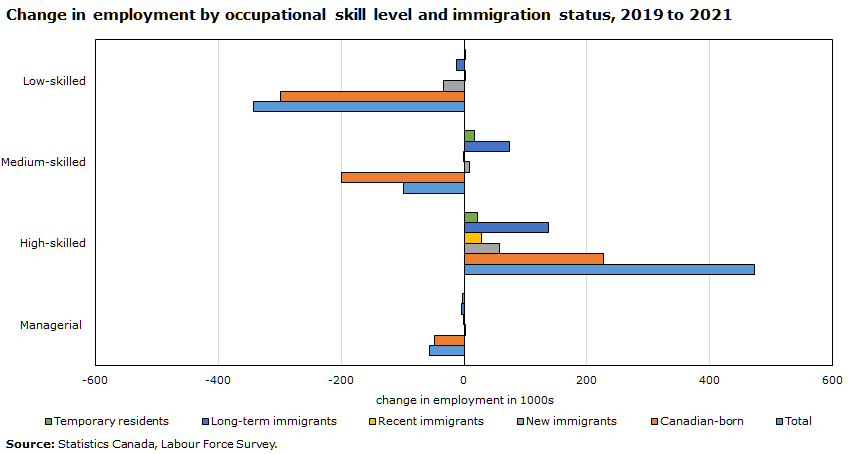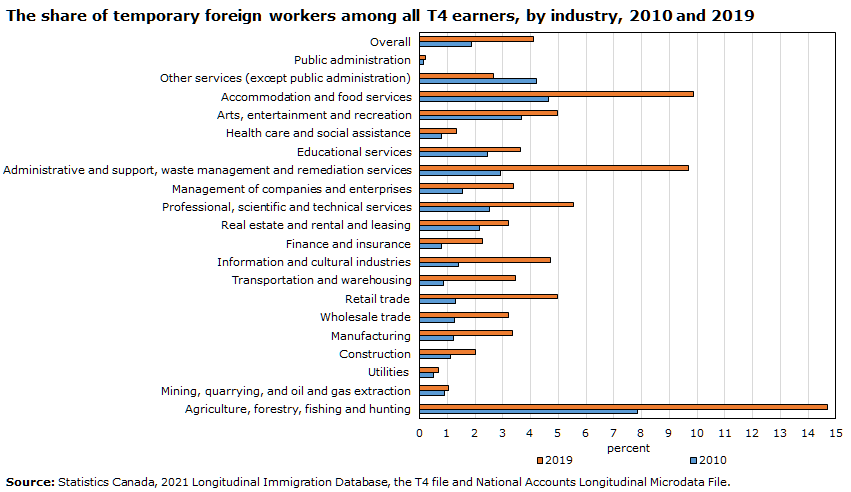Literature Review
International students on the Canadian employment market contribute significantly to the growth of the Canadian economy. International students with a first-time study visa have surged dramatically from 66,600 in 2000 to 429,000 in 2018 (Hou, et al., 2020). This was due to the growing number of overseas students and their increased labor market engagement (from 18% to 50%). At the non-university postsecondary level, the participation rate increased from 7% to 58%, and the number of participants increased from 3,000 to 173,000. As such, overseas students play a crucial role in the Canadian labor market (Crossman et al., 2021).
Certain Canadian provinces have a higher proportion of working study permit holders than others notably Prince Edward Island, British Columbia, Manitoba, and Ontario (Choi et al., 2021). The sectors in which foreign students have the largest work share are the housing and food service industries, but experienced students gain ground in the other sectors. In order to help the country’s economy grow, the government is also trying to get international students to work in different fields.
Under Canadian government laws, students with a Canadian study visa may work up to 20 hours per week throughout their studies and full-time during planned academic vacations. They are permitted to labor on campus without hourly restrictions. They will be able to cover their bills by working part-time, which is a big relief for students. There are many reasons for a foreign student to work in Canada, such as paying for daily expenses and tuition, learning about Canadian life in case they want to move there permanently, and getting academic experience through internships and co-op jobs.

From the diagram above (see Figure 1), long-term immigrant were highly employed in the high-skilled category representing approximately 180,000 compared to managerial work. The new immigrants in lieu of the international students represented close to 60,000, ranking fourth among the occupational job market category. In 2021, the proportion of new and recent immigrant employees in the lodging and food services industry reached 13%, 11% in the professional services sector, and 10% in the manufacturing and transportation sectors (Statistics Canada, 2022). In the manufacturing sector, the number of native-born employees decreased by 159,000 between 2019 and 2021 and was partially replaced by new and recent immigrants accounting for over +46,000 (Pandey, and Townsend, 2017). This report gives statistics on foreign students’ engagement and impact in the Canadian workforce.

Based on the aforementioned model (see Figure 2), TFWs accounted for 4.1% of all T4 earners in Canada in 2019, a significant rise from 1.8% in 2010. Particularly dependent on TFWs are the agricultural (15%), lodging and food services (10%), and administrative and support (10%) industries, as well as waste remediation management services (10%) (Statistics Canada, 2022). Also, there are more TFWs in the information and cultural sectors than in the professional, scientific, and technical services sector. The province with the highest proportion of foreign students in Canada in 2018 was Ontario, with 48.5%, followed by British Columbia with 22.1% (Crossman et al., 2021). Over the last two decades, Ontario ranked first in the number of study permit holders, and thus, the bulk of the international student workforce comprised graduates from Ontario.
More foreign students flocked to Ontario as a result of the province’s high population and plenty of educational institutions. This was due to the fact that Ontario had the most educational institutions and the largest population. In 2000, Quebec ranked second in terms of the number of foreign students, but the obstacles posed by the language barrier and the ease with which international students may relocate to other provinces made Quebec less appealing (Hou et al., 2020). Quebec is thus one of the provinces with the highest number of foreign students.
In conclusion, the Canadian graduate employment market has expanded over time. The employability of recent graduates is focused on several work sectors. According to the analysis, the lodging and food service sectors; business, construction, and support services; wholesale and retail trade; and professional, scientific, and technical services are all seeing clear and significant growth. Despite a decline in the employment of foreign students in the education sector from 2000 to 2019, international students have significantly contributed to reducing the scarcity of human resources on the Canadian job market. Even though Canada is the second-largest country in the world, it still has problems with developing its human resources. This is why it is bringing in more foreign students and growing its job market for recent graduates.
Critical Self-Reflection
Learning has always been among my favorite activities. I have always performed well in school in part owing to my intrinsic drive to learn everything. During the group assignment process as well as the preparation and real mock presentation for the business and management course, I was able to comprehend the importance of excellent communication, time management, problem-solving abilities, and a desire to learn as fundamental employability factors. As these teachings have progressed, they now include resolving disparate life experiences and creating analyses of intricate business-oriented works. Moreover, I have been able to enhance my brain in a more engaging, hands-on capacity outside of the classroom.
In addition, I have been able to improve my learning style and interactions with people inside the assigned groups to the extent that I have become a better person. I have come to feel that this maturity will also help me become a better thinker, one who has the patience to listen to and consider what others have to say. I regard learning to be a two-way street that must be taken seriously. It has been and will continue to be my primary objective as a student to become a conscientious pupil and gain all of the knowledge my lecturers have laid before me. The simulated presentation has also taught me how to evaluate my actions. It has also influenced my decision to study my courses and grow as a student, therefore having a profound effect on my life.
Nonetheless, I have struggled to accommodate and synthesize key notions pertaining to the foreign graduate employment market. Although I had never missed a deadline, I had issues with procrastination. Procrastination makes one to postpone duties making the achievement of tasks within the set deadlines futile (Xu, 2022). With the assistance of my co-workers, I was able to plan my days and tackle larger jobs in digestible chunks. Within the group, it was my responsibility to devise a strategy to ensure that all duties were performed within the allotted time as discussed in the research by Limone et al. (2020).
With this position, I am now able to formulate a strategy as soon as I get a new project, and I often beat my deadlines. Aside from procrastination concerns, I have been poor on the design side of things and have little expertise with content creation; therefore I would consider this a weakness. However, I am a fast student, and I am certain that I could increase my technical abilities if necessary for a future position.
I pondered enrolling in a brief online course on project management and time management in an effort to remedy the shortcoming described above and fulfill my allocated tasks within the group. Time management is the control of the time spent on project tasks and activities and the progress accomplished (Tabuenca et al., 2022). All project operations must be planned, scheduled, monitored, and controlled for excellent time management. With these technical abilities, I was able to manage and execute project design execution and procedures, which are essential technical skills in today’s labor market.
In addition to possessing the technical abilities necessary to manage and lead a company, I also possess a vast array of non-cognitive talents that are vital for developing good management and leadership practices. The critical thinking and knowledge abilities guarantee that graduates have a profound comprehension of several fields (Kulkarni, 2020). In this instance, I am hopeful and eager to assume a managerial and leadership position. In addition, I exhibit a high level of courtesy and intellectual interest towards on-going performance improvement. In addition, I have good interpersonal contact skills and a solid work ethic, which contribute to collaboration and positive performance under intense pressure. The sensitivity and self-awareness are necessary for harmonious integration with co-workers (Gonzales, 2022).
In this case, I possess a high degree of integrity and honesty, which is vital to my success as an employee. In addition, I have a solid grasp of the importance of time management within businesses and consistently complete given work by the due date.
The contemporary human resource department confronts a conundrum when recruiting prospective workers with the required capabilities to meet corporate objectives. The development seen in production and global markets compels businesses to seek personnel with a variety of talents in order to implement the sustainability agenda (Paauwe and Boon, 2018). Globalization, technological innovation, and increasing rivalry have led to improved communication, creativity, and critical thinking among workers, which has contributed to the success of businesses. Since Business and management course provide graduates with a broad range of study, skills, and research, I feel the curriculum has a great deal of promise to produce the skilled labor force in the future. As such, I am looking forward to entering the job market with a lot of technical, organizational, and interpersonal skills.
Reference List
Crossman, E, Choi, Y, and Hou, F. (2021) ‘International students as a source of labour supply: Engagement in the labour market during the period of study,’ Economic and Social Reports, 1(1), pp. 1-14. Web.
Gonzales, M. (2022). Workplace Emotions. Singapore: Springer.
Hou, F, Crossman, E, and Picot, G. (2020) ‘Two-step Immigration Selection: recent trends in immigrant labour market outcomes,’ Economic Insights, 113(1), 1-13. Web.
Kulkarni, M. (2020) ‘Time management skills among medical students,’ Indian J Public Health Res Dev, 11(6), pp. 488-93. Web.
Limone, P. et al. (2020) ‘Examining procrastination among university students through the lens of the self-regulated learning model,’ Behavioral Sciences, 10(12), p. 184. Web.
Lu,Y and Hou, F. (2019) Temporary foreign workers in the Canadian labor force: open versus employer-specific work permits. Web.
Paauwe, J. and Boon, C. (2018) Human resource management: A critical review. Routledge.
Pandey, M, and Townsend, J. (2017) ‘Prior host-country work experience and immigrant labor market outcomes: evidence from Canada.” IZA Journal of Migration, 6(3), pp. 1-22 Web.
Picot, et al. (2022) Transition to permanent residency by lower- and higher-skilled temporary foreign workers. Web.
Statisitcs Canada. (2022) Research to insights: immigration as a source of labour supply. Web.
Tabuenca, B., Greller, W. and Verpoorten, D. (2022) ‘Mind the gap: smoothing the transition to higher education fostering time management skills,’ Universal Access in the Information Society, 21(2), pp. 367-379. Web.
Xu, J. (2022) ‘More than minutes: a person-centered approach to homework time, homework time management, and homework procrastination,’ Contemporary Educational Psychology, 70 (1), p. 102087. Web.